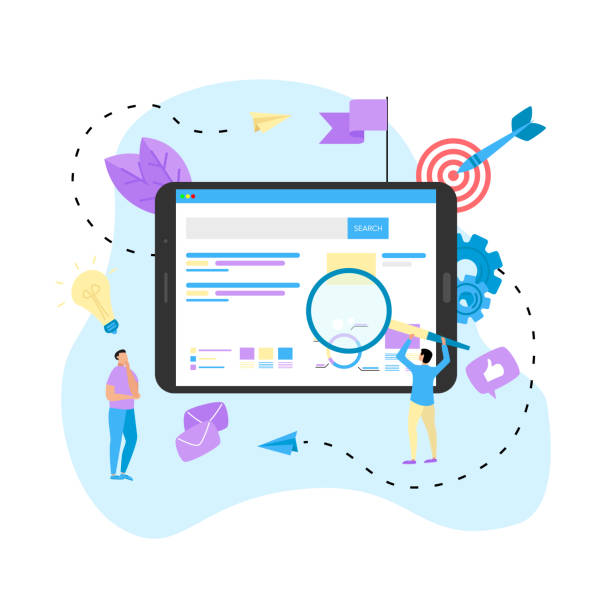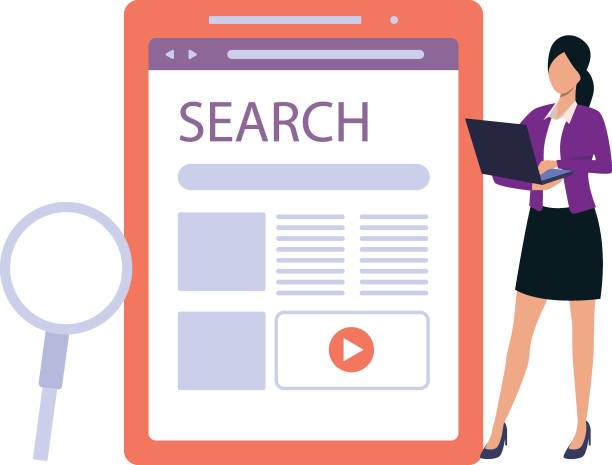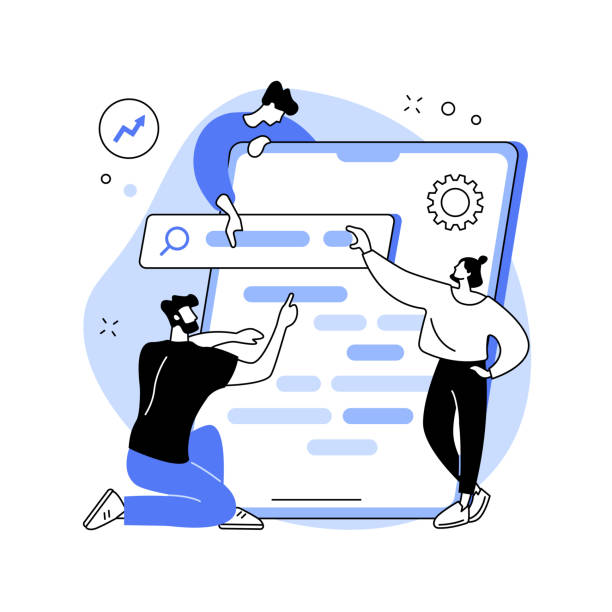Introduction to User-Friendly Website Design and Its Importance

User-friendly website design goes beyond mere aesthetic appeal; it’s a comprehensive approach to building websites that prioritize users’ needs and expectations.
In today’s digital world, where competition for attracting and retaining an audience is relentless, simply having a website is not enough.
Your website must provide a seamless and enjoyable experience for visitors.
This is where the concept of #user_friendly_website_design becomes important.
A #user_friendly website can increase conversion rates, improve customer satisfaction, and even strengthen your brand’s credibility.
The main goal of #user_centric_web_design is to reduce friction for the user in achieving their goal, whether that goal is purchasing a product, finding information, or making contact.
This educational approach shows us how we can look at our website from the users’ perspective.
The question that arises is: Is your website designed in such a way that users can find what they want without confusion and with minimal effort? Neglecting this issue can lead to high bounce rates and the loss of potential customers.
Therefore, a deep understanding of the principles of user-friendly website design is crucial for any business intending to succeed in the online space.
This is an explanation of the fundamental concepts of User Experience (UX) and User Interface (UI), which form the cornerstone of today’s successful websites and a guide to starting on the right path.
Research shows that 80% of customers trust companies with a professional website more. Does your current website inspire this trust?
With Rasaweb’s corporate website design services, permanently solve the problem of customer distrust and a weak online image!
✅ Create a professional image and increase customer trust
✅ Attract more sales leads and grow your business
⚡ Get free consultation
Key Principles of User Experience (UX) in Web Design

User-friendly website design is tied to a set of principles and rules aimed at enhancing user experience.
Among the most important of these principles is usability, which relates to the simplicity and efficiency of using the website.
Users should be able to navigate different sections of the site and achieve their goals without needing special training.
Another principle is findability; content and information should be easily accessible and searchable.
If a user cannot quickly find what they are looking for, they are likely to leave the site.
Also, accessibility is a vital principle that ensures the website is usable for all individuals, including those with disabilities.
This is a specialized topic that requires technical knowledge and adherence to specific standards.
Web accessibility is not just a legal requirement, but also demonstrates a business’s commitment to inclusivity and respect for all audiences.
In addition to these, user-centric web design emphasizes creating a clear and logical path for users, so that every stage of interaction with the site feels natural and intuitive.
This educational and guiding approach helps developers and designers look beyond aesthetics to the site’s structure and functionality, leading to a truly user-friendly website design.
Audience Analysis and User Persona Creation

One of the fundamental steps in user-friendly website design is a deep understanding of the target audience.
Without understanding who your users are, what their needs are, what challenges they face, and what their expectations are from your website, user-centric web design will not be possible.
This analytical and specialized stage involves collecting data through surveys, interviews, website traffic data analysis, and observing user behavior.
Tools like Google Analytics can provide valuable information about user demographics, traffic sources, and popular pages.
After collecting this information, the next step is to create user personas.
A user persona is a fictional character, based on real data, that represents different groups of your users.
These personas include details such as name, age, occupation, goals, motivations, pain points, and internet usage habits.
Creating detailed personas helps the user-friendly website design team make design decisions focused on the needs of real users.
For example, if your persona is someone who often uses mobile and has limited time, friendly UI design should focus on simplicity, loading speed, and responsiveness.
This process not only leads to a user-friendly website design but also helps in producing engaging content that aligns with user needs and is a very important guide for the entire project.
| Element | Description | Importance in Design |
|---|---|---|
| Name and Demographic Details | Name, age, occupation, marital status, place of residence | Creates a sense of reality and empathy with the user |
| Goals and Motivations | What the user wants to achieve on the site | Aligning site features with user needs |
| Pain Points | Challenges and problems the user faces | Identifying and resolving obstacles in user experience |
| Online Habits and Behaviors | How they use the internet, devices used | Optimizing design for different platforms and habits |
| Quote or Motto | A short sentence reflecting the user’s perspective | Summary of user’s essence and needs |
Information Architecture and Intuitive Navigation

Information Architecture (IA) is the backbone of any user-friendly website design.
This concept refers to organizing, structuring, and labeling content in such a way that users can easily find the information they need.
Poor information architecture can render even the most beautiful visual design ineffective, leading to user confusion and frustration.
In contrast, a strong IA optimizes the user experience and smooths the user’s path through the site.
This is a specialized aspect of user-centric web design that requires an understanding of user psychology and how they process information.
Navigation, or the site menu, is the main point of connection between the user and the information architecture.
An intuitive and clear navigation system allows the user to access different sections of the site without having to think.
This includes choosing appropriate names for menus, logically categorizing pages, and providing easy return paths.
Using “breadcrumbs” navigation (Breadcrumbs) can help users understand their location within the site.
To achieve a user-friendly website design, special attention must be paid to how menus are displayed on different devices, especially mobile.
Many websites use hamburger menus (Hamburger Menu) to save space, but it must be ensured that these menus are clearly discoverable and accessible.
This guide is key to preventing user wasted time and improving their overall experience on the site.
Ultimately, good navigation leads users where they want to go and allows them to feel comfortable with the site, which is one of the main goals of user-friendly website design.
Are you worried your company’s old website might scare away new customers? Rasaweb solves this problem with modern and efficient corporate website design.
✅ Increases your brand’s credibility.
✅ Helps attract targeted customers.
⚡ Contact Rasaweb for a free consultation!
Visual Design and Engaging User Interface (UI)

While User Experience (UX) relates to users’ “feelings” during interaction with a site, User Interface (UI) refers to the visual “look” and “feel” of the site.
A successful user-friendly website design is a harmonious combination of strong UX and engaging UI.
Visual elements such as colors, fonts, images, icons, and whitespace all play a role in shaping the user’s perception of the site.
Choosing an appropriate color palette can influence user emotions and strengthen brand identity.
For example, calming colors are more suitable for health websites, and exciting colors for entertainment sites.
Readable fonts, appropriate text sizes, and sufficient contrast between text and background are crucial points for ensuring content readability.
This is an explanatory and educational aspect of design.
Using high-quality images and videos can also enrich the visual experience and make content more entertaining and appealing, provided they do not reduce the site’s loading speed.
Friendly UI design involves paying attention to small details such as button design (size, color, hover states), data entry forms (simplicity and clarity), and visual feedback for user interactions.
All these elements should be designed to be not only beautiful but also functional and intuitive.
The goal of user-friendly website design from a UI perspective is to create a pleasant and practical visual experience that encourages users to stay on the site, interact more, and gives them the confidence to perform desired actions.
This part of user-centric web design directly influences user emotions and perceptions.
Responsiveness (Responsive Design) and Accessibility

In today’s digital age, users access the internet from various devices; from desktop computers to tablets and smartphones.
Therefore, a user-friendly website design must ensure that the website is displayed correctly and functions properly on any screen size.
This concept is known as responsive design or responsive design and is a specialized and essential aspect of user-centric web design.
Responsive websites automatically adapt their layout, images, and text to the user’s screen size, providing a seamless user experience.
Failure to adhere to this principle can lead to high bounce rates and the loss of a significant portion of mobile traffic.
In addition to responsiveness, web accessibility is also one of the main pillars of user-friendly website design.
Accessibility means ensuring that your website is usable for all individuals, including those with visual, auditory, motor, or cognitive disabilities.
This includes providing alternative text for images, using appropriate color contrasts, enabling keyboard navigation, and offering subtitles for video content.
This is an educational and ethical discussion that holds great importance in the development of web inclusivity.
Standards and guidelines such as WCAG (Web Content Accessibility Guidelines) provide a framework for achieving this goal.
Adhering to accessibility not only benefits individuals with disabilities but can also improve your site’s SEO, as search engines also use these standards to better understand content.
A truly user-friendly website design leaves no user behind.
Website Speed and Performance Optimization

A website’s loading speed has a direct impact on user experience and, consequently, on its success.
In today’s world where users have high expectations for speed, every second of delay can mean losing visitors and customers.
Research has shown that a significant portion of users leave a site if it doesn’t load within a few seconds.
Therefore, speed optimization is a critical component of user-friendly website design.
This is a specialized and analytical topic that requires careful examination of various factors.
Several factors can affect site loading speed, including the size of images and videos, suboptimal coding, improper hosting choice, and lack of CDN (Content Delivery Network) usage.
To improve speed, various actions can be taken: compressing images without noticeable quality loss, minifying CSS and JavaScript codes, enabling browser caching, and using high-performance hosting.
These guidelines can make a significant difference in your site’s speed.
Furthermore, continuous monitoring of site speed with tools like Google PageSpeed Insights or GTmetrix is essential to identify and address potential bottlenecks.
A user-friendly website design should not only be beautiful and efficient but also load at lightning speed to provide users with a smooth and delay-free experience.
This element is increasingly becoming an important piece of news in the world of interactive web design.
| Metric | Explanation | Importance for UX |
|---|---|---|
| LCP (Largest Contentful Paint) | Time to load the largest visible content element | Indicates the speed of the main content for the user |
| FID (First Input Delay) | Delay between the user’s first interaction and the browser’s response | Measures the site’s responsiveness to user interactions |
| CLS (Cumulative Layout Shift) | Amount of unexpected visual element movement during loading | Direct impact on visual stability and user experience |
| TTFB (Time To First Byte) | Time to receive the first byte of data from the server | Indicates server response speed |
| Speed Index | Average time for visible content of the page to load | Overall assessment of page visual loading speed |
Content Strategy and Its Role in UX

Content is king, but in user-friendly website design, content is a king that is well-organized and presented.
Content strategy plays a pivotal role in user experience, as many users’ primary goal is to find information, get answers to questions, or use services provided through content.
Site content should not only be relevant and high-quality but also written and designed in a way that is easily understandable and consumable.
This is an educational and explanatory dimension of user-centric web design.
For a user-friendly website design, content should:
- Be clear and concise: Avoid complex sentences and unnecessary technical jargon.
- Be readable: Use headings, subheadings, lists, and short paragraphs to improve readability.
- Be helpful and valuable: Content should answer users’ questions and address their needs.
- Be web-optimized: Use appropriate keywords for SEO and optimize content for scanning rather than line-by-line reading.
Engaging content can prompt users to interact more and think deeper, while entertaining content can increase user retention rates.
Also, paying attention to brand tone and voice in content helps create a sense of coherence and trust among users.
Ultimately, content strategy must align with the overall goals of user-friendly website design and your business objectives.
A successful user experience design transforms content into a powerful tool for guiding users and satisfying their needs.
This is a precise analysis of content’s importance in online success.
Does your current corporate website not reflect your brand’s credibility and power as it should? Rasaweb solves this challenge for you with professional corporate website design.
✅ Increase visitor credibility and trust
✅ Attract more targeted customers
⚡ Click to get a free consultation!
User Testing and Continuous Improvement

After implementing user-friendly website design, your work isn’t over; in fact, it’s just beginning.
To ensure your website is truly user-friendly and meets the audience’s needs, user testing and continuous improvement are essential.
This analytical and guiding process helps you identify the strengths and weaknesses of your design from the perspective of real users.
User testing can be done in various ways:
- Usability Testing: You ask real users to perform specific tasks on the site, while you observe their behavior and record potential problems.
- A/B Testing: You show two different versions of a page or design element to different groups of users to see which one performs better.
- Surveys and Feedback: You ask users to provide their opinions about their experience on the site.
- Heatmap and Session Recording Analysis: Using tools like Hotjar, you can see exactly where users click, where they scroll, and how they navigate the site.
Findings from tests should be used as input for iterative improvements in design.
This continuous cycle of design, testing, analysis, and improvement ensures that your website always keeps pace with user needs and expectations.
User-friendly website design is a dynamic process, not a one-time project.
With this approach, you can prevent major problems from becoming news and always stay one step ahead.
This is the most specialized aspect of website maintenance and development.
Tools and Resources for User-Friendly Design

To create and maintain a user-friendly website design, designers and developers need a set of tools and resources.
These tools can be helpful at every stage of the design process, from ideation and wireframing to testing and analysis.
Familiarity with these specialized tools is an essential guide for anyone working in user-centric web design.
Some important tools include:
- Design and Prototyping Tools: Adobe XD, Figma, Sketch – These tools are used for designing user interfaces (UI), creating wireframes, and interactive prototypes that help visualize user-friendly website design.
- User Testing Tools: Hotjar, UserTesting, Google Optimize – for collecting user feedback, analyzing their behavior, and conducting A/B tests.
These tools provide valuable analytical insights. - Web Analytics Tools: Google Analytics, Google Search Console – for monitoring site traffic, user behavior, and SEO performance.
- Learning Resources: Specialized UX/UI blogs, online courses (Coursera, Udemy), reference books.
These educational resources ensure your knowledge in user-friendly website design stays up-to-date.
Smart use of these tools and resources enables the design team to work more efficiently and make data-driven decisions.
Furthermore, following news and new trends in this field is of great importance, as the world of friendly user interface design is constantly evolving.
Frequently Asked Questions
And other services of Rasa Web advertising agency in the field of advertising
- Smart Direct Marketing: A specialized service for increasing sales growth based on customizing user experience.
- Smart Marketplace: Designed for businesses looking to manage campaigns through the use of real data.
- Smart Marketplace: A combination of creativity and technology for user interaction by optimizing key pages.
- Smart Website Development: An innovative service for improving SEO ranking through engaging UI design.
- Smart Digital Branding: A fast and efficient solution for increasing website traffic with a focus on intelligent data analysis.
And hundreds of other services in the field of internet advertising, advertising consultation, and organizational solutions
Internet Advertising | Advertising Strategy | Advertorial
Resources
Website Design Guide
Comprehensive Website Design Guide
Complete Website Design Guide
Information Architecture and User Experience
? For your business to leap forward in the digital world and reach more customers, Rasaweb Afarin Digital Marketing Agency, with expertise in user-friendly website design and comprehensive online marketing solutions, is with you.
📍 Tehran, Mirdamad Street, next to Bank Markazi, Southern Kazeroon Alley, Ramin Alley, No. 6

